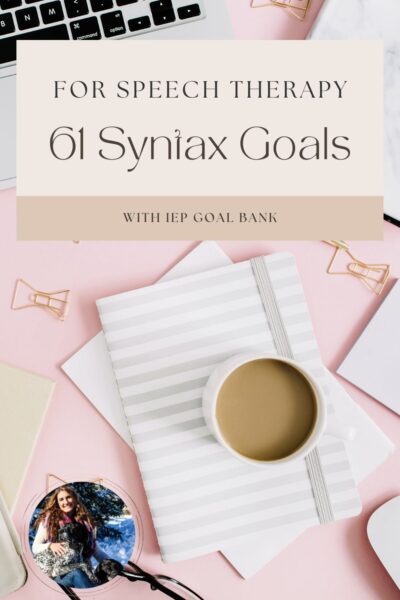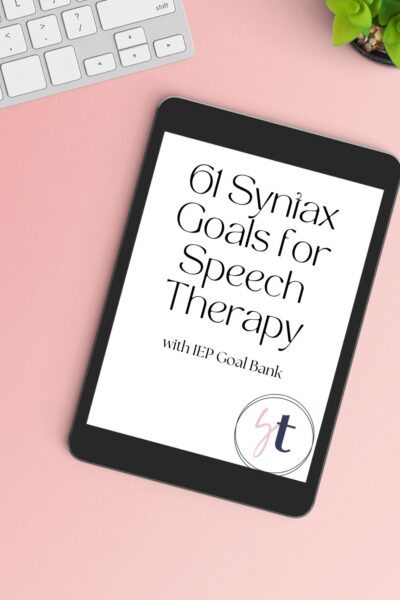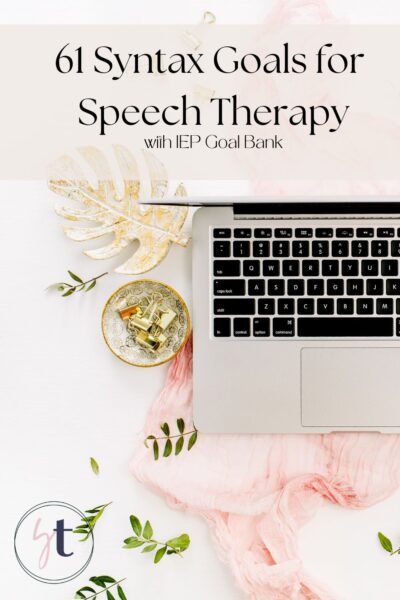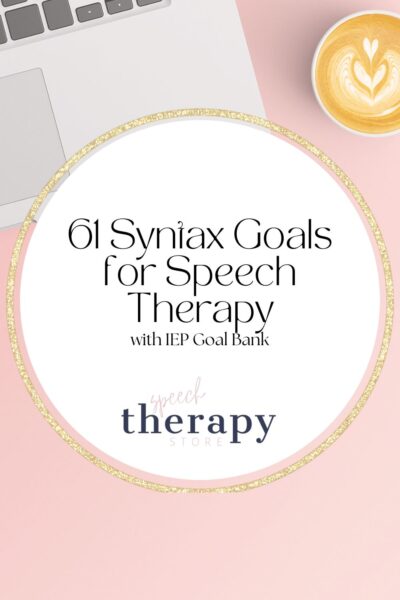If you’re a speech therapist looking for a massive list of syntax goals for speech therapy this blog post is for you!
Let’s just say goal writing was never my favorite thing to do.
That’s exactly why I wanted to take writing goals off your to-do list!
I wanted to turn this annoying and sometimes difficult task into a simple copy and paste. I mean who doesn’t love a good copy-and-paste option?
Below is a list of smart goals that you can use for your syntax communication skills goal writing and hopefully making your workday a little less stressful.

Visual Prompts
Using visual cues, such a picture cue when working on syntax skills can be very helpful for our students with language disorders. In addition, you can use helpful verbal prompts to help guide your student to the correct answer as well.
Long-Term Goal: Syntax Goals for Speech Therapy
Below is an IEP goal bank filled with syntax goals for my fellow Speech-Language Pathologist who is working in the school setting or private practice settings.
Expressive Language – Syntax Goals for Speech Therapy
Given a picture or story, STUDENT will use nouns to answer WHO or WHAT questions with 80% accuracy in 4 out of 5 opportunities.
Given a picture or story, STUDENT will use verbs to tell actions with 80% accuracy in 4 out of 5 opportunities.
Given a picture or story, STUDENT will use a prepositional phrase to answer WHERE questions with 80% accuracy in 4 out of 5 opportunities.
Given a picture or story, STUDENT will use a prepositional phrase or adjective to answer HOW questions with 80% accuracy in 4 out of 5 opportunities.
Given common objects or a picture, STUDENT will use 2 words to call attention to an object (e.g., “this ball”, “my shoe”) with 80% accuracy in 4 out of 5 opportunities.
Given an object or a picture, STUDENT will use 2 words to show the disappearance of an object (e.g., “no cracker”, “apple all gone”) with 80% accuracy in 4 out of 5 opportunities.
Given an object or a picture, STUDENT will use 2 words to indicate the recurrence of an object (e.g., “more cracker”) with 80% accuracy in 4 out of 5 opportunities.
Given an object or a picture, STUDENT will use 2 words that contain an adjective and a noun (e.g., “big bear”) with 80% accuracy in 4 out of 5 opportunities.
Given an object or a picture, STUDENT will use 2 words to show possession of an object (e.g., “Daddy car”) with 80% accuracy in 4 out of 5 opportunities.
Given an object or a picture, STUDENT will use 2 words to show an action object (e.g., “read book“) with 80% accuracy in 4 out of 5 opportunities.
Given an object or a picture, STUDENT will use 2 words to show the location of an object (e.g., “dog car”) with 80% accuracy in 4 out of 5 opportunities.
Given an object or a picture, STUDENT will use 2 words to show agent action (e.g., “dog jump”) with 80% accuracy in 4 out of 5 opportunities.
Given an object or a picture, STUDENT will use 2 words to show emotion (e.g., “baby tired”) with 80% accuracy in 4 out of 5 opportunities.
Given an object or a picture, STUDENT will use 2 words to achieve the desired end of an object (e.g., “go home”) with 80% accuracy in 4 out of 5 opportunities.
Given an object or a picture, STUDENT will say 3 to 4-word utterances (e.g., “dog sitting in car”) with 80% accuracy in 4 out of 5 opportunities.
Given an activity, picture, or story, STUDENT will form grammatically correct simple sentences with 80% accuracy in 4 out of 5 opportunities.
Given an activity, picture, or story, STUDENT will form grammatically correct complex sentences with 80% accuracy in 4 out of 5 opportunities.
Given an activity, picture, or story, STUDENT will use correct subject-verb agreement in sentences with 80% accuracy in 4 out of 5 opportunities.
Given an activity, picture, or story, STUDENT will use all necessary propositions in sentences with 80% accuracy in 4 out of 5 opportunities.
Given an activity, picture, or story, STUDENT will use compound sentences (i.e., and, but, or, etc.) with 80% accuracy in 4 out of 5 opportunities.
Given an activity, picture, or story, STUDENT will use correct subject-verb agreement with 80% accuracy in 4 out of 5 opportunities.
Receptive Language – Syntax Goals for Speech Therapy
Given a verbal question, STUDENT will select a single word picture of the noun that tells WHO and WHAT with 80% accuracy in 4 out of 5 opportunities.
Given a story read aloud, STUDENT will select the picture of the noun that tells WHO and WHAT with 80% accuracy in 4 out of 5 opportunities.
Given a verbal question, STUDENT will select the picture of the verb that tells the action with 80% accuracy in 4 out of 5 opportunities.
Given a story read aloud, STUDENT will select the picture of the verb that tells the action with 80% accuracy in 4 out of 5 opportunities.
Given a verbal question, STUDENT will select the picture that tells WHERE with 80% accuracy in 4 out of 5 opportunities.
Given a story read aloud, STUDENT will select the picture that tells WHERE with 80% accuracy in 4 out of 5 opportunities.
Given a verbal question, STUDENT will select the picture that tells HOW with 80% accuracy in 4 out of 5 opportunities.
Given a story read aloud, STUDENT will select the picture that tells HOW with 80% accuracy in 4 out of 5 opportunities.
Given a two word phrase that calls attention to an object or picture (e.g., “that car”, “her toy”), STUDENT will answer “yes or no” if the phrase describes the object or picture accurately with 80% accuracy in 4 out of 5 opportunities.
Given an object or picture and a phrase that shows the disappearance (e.g., “crackers all gone”, “no cookie”), STUDENT will answer “yes or no” if the phrase describes the object or picture accurately with 80% accuracy in 4 out of 5 opportunities.
Given an object or picture and a phrase that shows the recurrence (e.g., “more crackers”), STUDENT will answer “yes or no” if the phrase describes the object or picture accurately with 80% accuracy in 4 out of 5 opportunities.
Given an object or picture and a phrase that contains an adjective and a noun (e.g., “red shoe”, “big ball”), STUDENT will answer “yes or no” if the phrase describes the object or picture accurately with 80% accuracy in 4 out of 5 opportunities.
Given an object or picture and a phrase that shows possession (e.g., “Dad’s cat”, “girl’s shoe”), STUDENT will answer “yes or no” if the phrase describes the object or picture accurately with 80% accuracy in 4 out of 5 opportunities.
Given an object or picture and a phrase that uses action object form (e.g., “Tie shoe”, “read book“), STUDENT will answer “yes or no” if the phrase describes the object or picture accurately with 80% accuracy in 4 out of 5 opportunities.
Given an object or picture and a phrase that indicates the location (e.g., “pencil down”, “car outside”), STUDENT will answer “yes or no” if the phrase describes the object or picture accurately with 80% accuracy in 4 out of 5 opportunities.
Given an object or picture and a phrase that uses agent action form (e.g., “boy jump”, “girl eat”), STUDENT will answer “yes or no” if the phrase describes the object or picture accurately with 80% accuracy in 4 out of 5 opportunities.
Given an object or picture and a phrase that shows an emotion (e.g., “girl sad”, “man angry”), STUDENT will answer “yes or no” if the phrase describes the object or picture accurately with 80% accuracy in 4 out of 5 opportunities.
Given an object or picture and a phrase to achieve a desired end (e.g., “shoe on”, “go home”), STUDENT will answer “yes or no” if the phrase describes the object or picture accurately with 80% accuracy in 4 out of 5 opportunities.
Given an object or picture and a phrase to achieve a desired end (e.g., “shoe on”, “go home”), STUDENT will answer “yes or no” if the phrase describes the object or picture accurately with 80% accuracy in 4 out of 5 opportunities.
Given a phrase or sentence structure that includes articles (e.g., “a”, “an”, “the”, and “some”), STUDENT will answer “yes or no” if the phrase or sentence uses the articles accurately with 80% accuracy in 4 out of 5 opportunities.
Given a phrase or sentence that includes adjectives (e.g., “this”, “that”, “these”, and “those”), STUDENT will answer “yes or no” if the phrase or sentence uses the adjectives accurately with 80% accuracy in 4 out of 5 opportunities.
Given a phrase or sentence that includes plurals (e.g., s, es) and irregular plural nouns, STUDENT will answer “yes or no” if the phrase or sentence uses the plurals accurately with 80% accuracy in 4 out of 5 opportunities.
Given a phrase or sentence that includes possessive nouns (e.g., “the girl’s bike”), STUDENT will answer “yes or no” if the phrase or sentence uses the possessive accurately with 80% accuracy in 4 out of 5 opportunities.
Given a phrase or sentence that includes subject pronouns (e.g., “I”, “he”, “she”, “you”, “we” “they”), STUDENT will answer “yes or no” if the phrase or sentence uses the pronoun accurately with 80% accuracy in 4 out of 5 opportunities.
Given a phrase or sentence that includes object pronouns (e.g., “me”, “him”, “her”, “you”, “us”, “them”), STUDENT will answer “yes or no” if the phrase or sentence uses the pronoun accurately with 80% accuracy in 4 out of 5 opportunities.
Given a phrase or sentence that includes possessive pronouns (e.g., “my/mine”, “his”, “her/hers”, “your/yours”, “our/ours”, “their/theirs”), STUDENT will answer “yes or no” if the phrase or sentence uses the pronoun accurately with 80% accuracy in 4 out of 5 opportunities.
SEE ALSO: IEP Goal Bank Posts
Given a phrase or sentence that includes reflexive pronouns (e.g., “myself”, “himself”, “herself”, “yourself”, “yourselves”, “ourselves”, “themselves”), STUDENT will answer “yes or no” if the phrase or sentence uses the pronoun accurately with 80% accuracy in 4 out of 5 opportunities.
Given a phrase or sentence that includes present progressive verb tenses (e.g., “The man is running”, “The girls are waving”), STUDENT will answer “yes or no” if the phrase or sentence uses the verb tense accurately with 80% accuracy in 4 out of 5 opportunities.
Given a phrase or sentence that includes past progressive verb tense (e.g., “The man was running”, “The girls were waving”), STUDENT will answer “yes or no” if the phrase or sentence uses the verb tense accurately with 80% accuracy in 4 out of 5 opportunities.
Given a phrase or sentence that includes present tense “s” and “es” marker (e.g., “The boy jogs”, and “The bee buzzes”), STUDENT will answer “yes or no” if the phrase or sentence uses the tense accurately with 80% accuracy in 4 out of 5 opportunities.
Given a phrase or sentence that includes “have” and “has” (e.g., “The boy has a dog”, and “The girls have ice skating”), STUDENT will answer “yes or no” if the phrase or sentence uses the tense accurately with 80% accuracy in 4 out of 5 opportunities.
Given a phrase or sentence that includes regular past tense (e.g., “The dog jumped”), STUDENT will answer “yes or no” if the phrase or sentence uses the tense accurately with 80% accuracy in 4 out of 5 opportunities.
Given a phrase or sentence that includes irregular past tense (e.g., “The boy ran”), STUDENT will answer “yes or no” if the phrase or sentence uses the tense accurately with 80% accuracy in 4 out of 5 opportunities.
Given a phrase or sentence that includes reflexive pronouns (e.g., “myself”, “himself”, “herself”, “yourself”, “yourselves”, “ourselves”, “themselves”), STUDENT will answer “yes or no” if the phrase or sentence uses the pronoun accurately with 80% accuracy in 4 out of 5 opportunities.
Given a phrase or sentence that includes present progressive verbs tense (e.g., “The man is running”, “The girls are waving”), STUDENT will answer “yes or no” if the phrase or sentence uses the verb tense accurately with 80% accuracy in 4 out of 5 opportunities.
Given a phrase or sentence that includes past progressive verb tense (e.g., “The man was running”, “The girls were waving”), STUDENT will answer “yes or no” if the phrase or sentence uses the verb tense accurately with 80% accuracy in 4 out of 5 opportunities.
Given a phrase or sentence that includes present tense “s” and “es” marker (e.g., “The boy jogs”, and “The bee buzzes”), STUDENT will answer “yes or no” if the phrase or sentence uses the tense accurately with 80% accuracy in 4 out of 5 opportunities.
Given a phrase or sentence that includes “have” and “has” (e.g., “The boy has a dog”, and “The girls have ice skating”), STUDENT will answer “yes or no” if the phrase or sentence uses the tense accurately with 80% accuracy in 4 out of 5 opportunities.
Given a phrase or sentence that includes regular past tense (e.g., “The dog jumped”), STUDENT will answer “yes or no” if the phrase or sentence uses the tense accurately with 80% accuracy in 4 out of 5 opportunities.
Given a phrase or sentence that includes irregular past tense (e.g., “The boy ran”), STUDENT will answer “yes or no” if the phrase or sentence uses the tense accurately with 80% accuracy in 4 out of 5 opportunities.
SEE ALSO: 432+ Free Measurable IEP Goals and Objectives Bank

Speech Therapy Goals – Short-Term Goal Objectives
I know every district has different ways it requires their objectives to be written, but typically my district wanted us to reduce either the number required or the percentage of achievement.
Here are a few examples to help get you started.
If we take a sample goal:
“Given an object or picture, STUDENT will say 3 to 4-word utterances (e.g., “dog sitting in car”) with 80% accuracy over 3 out of 4 consecutive sessions.”
- Reduced Number or Trials Required: The objective might be, “Given an object or picture, STUDENT will say 2 to 3-word utterances (e.g., “dog in car”) with 80% accuracy over 3 out of 4 consecutive sessions.”
- Reduce Percentage of Accuracy: The objective might be, “Given an object or picture, STUDENT will say 3 to 4-word utterances (e.g., “dog sitting in car”) with 70% accuracy over 3 out of 4 consecutive sessions.”
- Reduce Difficulty of Task: The objective might be, “Given an object or picture, STUDENT will use a sentence strip to create a 3 to 4-word utterance (e.g., “dog sitting in car”) with 80% accuracy over 3 out of 4 consecutive sessions.”
- Reduce Number of Sessions of Accuracy: The objective might be, “Given an object or picture, STUDENT will say 3 to 4-word utterances (e.g., “dog sitting in car”) with 80% accuracy over 2 out of 4 consecutive sessions.”
(Meaning out of 4 therapy sessions in a row. They used 3 to 4-word utterances 2 out of 4 or 50% of the time in order to mark that goal mastered.)
As speech therapists, you are the specialist and you know your student’s and child’s ability best though, so just take the goals and simplify them into achievable steps for your specific student.
Data Collections – Syntax Goals for Speech Therapy
If you’re a classroom teacher or speech pathologist in need of data tracking forms while working on your student’s syntax goals for speech therapy then be sure to check out my IEP goal data tracking for progress monitoring forms.
Or if you simply want a list of data sheets to choose from then be sure to check out my list of 35 free speech therapy data sheets roundup.
Measurable Goals
Are you also looking for other speech goals? If so, be sure to check out my master list of IEP goals here.
This list of goal setting also includes the following speech-language intervention goals:
- Communication Device – AAC User
- Figurative Language
- Language Goals
- Pragmatic Language Goals
- Sign Language
- Easy Onset & Slow Rate
- Body Language
- Articulation Goals (Word Level, Phrase Level, Sentence Level, and Conversation)
These are just a few of the goals listed on this master list of over 432 IEP goals.
Syntax Goals for Speech Therapy Resources:
Below I’ve outlined a list of helpful free worksheets to help with your syntax therapy planning.
Sentence Level – Complete Sentence
Practice your child’s or student’s syntax language tasks while practicing appropriate grammar at the sentence level.
- Scrambled Sentences FREEBIE for Google Slides™ | Distance Learning by K is for Kinderrific is a fun and interactive game to practice syntax while unscrambling sentences!
- Flip Flop Fragments (Changing Fragments into Sentences) by The Peanut Circus is a great activity to practice syntax to work on complete sentences.

Complex Syntax
Here is a freebie to work on your child’s syntax word order language therapy.
- FREE Snowy Sentence Building by Pirate Girls Education Invasion is a fun activity to practice your student’s syntax understanding as they use an interactive snowman to order words.
- Sentence Scrambles for Speech Therapy! By Jenn Alcorn is a highly-rated game that prompts students to unscramble sentences and practice syntax.
Structured Language Activities
The first step I like to use when working on syntax is to start with a structured activity.
- How to Write a Fable Writing Template by Shari Popejoy is a template you can use to help students understand using syntax as they use structured language to write their own fable.
- Easter Syntax Story: (Past Tense -ed) by Stalwart Speech and Language is a resource that models the syntactical structure of past tense stories.
SEE ALSO: 193+ Multiple Meaning Words Grouped by Grade + Free Worksheets
Correct Sentence
Another fun structured activity is to have your students practice correcting a sentence.
- FREE Daily Sentence Editing / Correcting Worksheets – Print & Digital by The Teaching Rabbit is a highly-rated freebie that has electronic and print versions of Fix the Sentence worksheets. Fixing sentences is a great way to practice syntax.
- Editing A Sentence (Sentence editing) – December and January by Rachael Fox is a great resource for students to practice correcting basic grammar and punctuation in sentences.
School-Aged Children
Here are a few activities that are perfect for your young children.
- Build a Sentence Sight Word Sentence Scrambles FREEBIE by Danielle Mastandra is a great activity to use with pre-k to 3rd grade. Students will use sight words to build sentences.
- FREE Valentine Sentences Using Conjunctions by Kayla SLP is a fun and interactive resource that prompts students to write valentines with conjunctions. This is a fun way to celebrate the holiday and practice syntax.
Short Story
Another strategy to work on syntax language development is to use short stories.
- Speech and Language Therapy-WH- QUESTION COMPREHENSION by Kristen Marshall MS CCC SLP is a compilation of 30 single sentences or “stories” that ask syntax and “wh” related questions to assess the students’ understanding.
- “The Fisherman and His Wife” Lesson Plan by Achieve the Core is a highly rated 5-day exemplar for students to practice searching and interpreting textual connections. This printable packet includes student discussion activities, vocab and syntax tasks, and text-dependent questions.

Sentence Combining
Sentence combining is also a great way to work on your student’s syntax language skills.
- Combining Sentences Task Cards, Grammar Practice, Common Core Aligned by The Gilded Classroom is a ready-to-go packet to practice syntax and other grammar practices.
- Monster Mash: A Conjunction Activity by Free Range SLP is a freebie that is interactive and fun! Students play a game to practice using conjunctions in relation to syntax and combining 2 sentences.
In Conclusion: Syntax Goals for Speech Therapy
I hope you found this list of syntax goals for speech therapy helpful.
Feel free to spend less time creating your own syntax goals and copy and paste the goals above.
Want Even More Language Skills for Speech Therapy?
- 917+ Best Free Boom Cards for Speech Therapy
- 31 Best Wordless Videos to Teach Problem Solving
- 133+ Categories List for Speech Therapy
- Best IEP Resources
Want the Best of the Bests?
Be sure to check out our most popular posts below!
